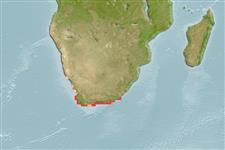Actinopterygii (ray-finned fishes) >
Perciformes (Perch-likes) >
Clinidae (Clinids)
Etymology: Blennophis: Greek,blenios = mucus + Greek, ophis= serpent (Ref. 45335).
Environment / Climate / Range
Ecology
Marine; demersal. Subtropical, preferred ?; 27°S - 35°S
Southeast Atlantic: Lüderitzbucht, Namibia to East London, South Africa.
Size / Weight / Age
Maturity: Lm ? range ? - ? cm
Max length : 30.0 cm TL male/unsexed; (Ref. 5496)
Short description
Morphology | Morphometrics
Dorsal
spines
(total): 46 - 50;
Dorsal
soft rays
(total): 2-4;
Anal
spines: 2;
Anal
soft rays: 33 - 37. Red or brown in color; large black blotch below 1st 3 dorsal spines; black dots around eye and on body (Ref. 5496). Juveniles black with red margins to dorsal, anal and caudal fins; small juveniles purple-black with a white caudal fin (Ref. 5496).
Found in pools and subtidal areas.
Life cycle and mating behavior
Maturity | Reproduction | Spawning | Eggs | Fecundity | Larvae
Smith, M.M., 1986. Clinidae. p. 758-769. In M.M. Smith and P.C. Heemstra (eds.) Smiths' sea fishes. Springer-Verlag, Berlin. (Ref. 5496)
IUCN Red List Status (Ref. 115185)
CITES (Ref. 94142)
Not Evaluated
Threat to humans
Harmless
Human uses
More information
Common namesSynonymsMetabolismPredatorsEcotoxicologyReproductionMaturitySpawningFecundityEggsEgg development
Age/SizeGrowthLength-weightLength-lengthLength-frequenciesMorphometricsMorphologyLarvaeLarval dynamicsRecruitmentAbundance
ReferencesAquacultureAquaculture profileStrainsGeneticsAllele frequenciesHeritabilityDiseasesProcessingMass conversion
Tools
Special reports
Download XML
Internet sources
